The Livingstone Online Code
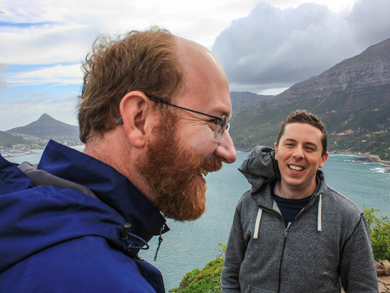
Cite page (MLA): Wisnicki, Adrian S. "The Livingstone Online Code." Megan Ward, ed. Livingstone Online. Adrian S. Wisnicki and Megan Ward, dirs. University of Maryland Libraries, 2015. Web. http://livingstoneonline.org/uuid/node/b1d5286c-4650-4d31-bafe-d33892f53573.
This section describes the ideals that guide the development of Livingstone Online as a whole and determine its day-to-day practices as a digital project that collaborates with individuals and institutions around the world and that takes seriously its responsibilities as a publicly funded and accountable entity.
Introduction Top ⤴
Livingstone Online presents Livingstone’s legacy in all its complexity. We celebrate Livingstone’s vision of human equality, which distinguished him among contemporary Victorian travelers to Africa. We recognize the value of his writings in illuminating African history and culture, European imperialism, and the nineteenth-century slave trade. We also acknowledge postcolonial critiques of Livingstone’s works and of the imperial project as a whole, and so strive not to perpetuate Victorian imperial stereotypes of the non-Western world.
Yet overall the directors of Livingstone Online take inspiration from Livingstone’s idealism to guide the development of our site. We also feel gratitude for the personal support that has been directed towards our work and for the many long-term professional relationships that our work has engendered. As a result, we strive to carry out our research according to what might be termed the Livingstone Online code. This code serves as one of the most important facets in our efforts to develop a publicly-oriented digital project. At the core of this code reside five elements:
Cross-cultural awareness Top ⤴
Livingstone Online is an international project. Our leadership currently resides in the US and the UK, while our collaborators come from both countries as well as South Africa and other parts of the world. The distributed nature of our project offers an immense advantage to our research practices, but also means that we must be responsible for the two-way flow of knowledge, for giving to those places from which we take.
For instance, in drafting our grant applications, we ensure that we can meet with collaborators and representatives of partner institutions face to face. Such meetings play a key role in strengthening our working relationships, but also enable us to gain firsthand feedback and ensure that all stakeholders have a genuine stake in our project. We have also created an outreach program that, we hope, will enable those communities that have been most supportive of our work to engage with and indeed benefit from the resources available on Livingstone Online.
On our website, we strive to be attentive in presenting information in order not to replicate the Victorian prejudices inherent in Livingstone’s works and those of other Victorian-era writers. We try to formulate our discussions of non-Western peoples in an informed manner, we take account of corrective modern scholarship, and we recognize that even seemingly neutral words like “discovery” and “natives” – words that continue to be bandied about in popular discussions of Livingstone’s legacy – have a history and can misrepresent both nineteenth-century and contemporary realities.

Pocket compass used by David Livingstone throughout his travels. Copyright David Livingstone Centre and Roddy Simpson. Object images used by permission. May not be reproduced without the express written consent of the National Trust for Scotland, on behalf of the Scottish National Memorial to David Livingstone Trust (David Livingstone Centre).
Responsible conduct towards project partners Top ⤴
More than one hundred archives and individuals around the world hold original David Livingstone manuscript items. To date, Livingstone Online has partnered with nearly half this number to publish high quality images and/or rigorous transcriptions of these items.
In some cases, our staff has collaborated closely with partners to ensure that our digital facsimiles meet institutional requirements and needs. In other cases, institutions and individuals have given us unfettered permission to publish images and/or transcription, or allowed our users to reuse these images under some form of Creative Commons.
In return institutions and individuals often ask for little more than acknowledgment and our word that we will adhere to our agreements with them. Our partnerships, therefore, rely on a high degree of trust. We consider such commitment to our site an honor and privilege, and, as a result, make a significant effort to ensure that we meet the terms of all agreements and that our use of primary materials repays and indeed justifies the trust put in us.
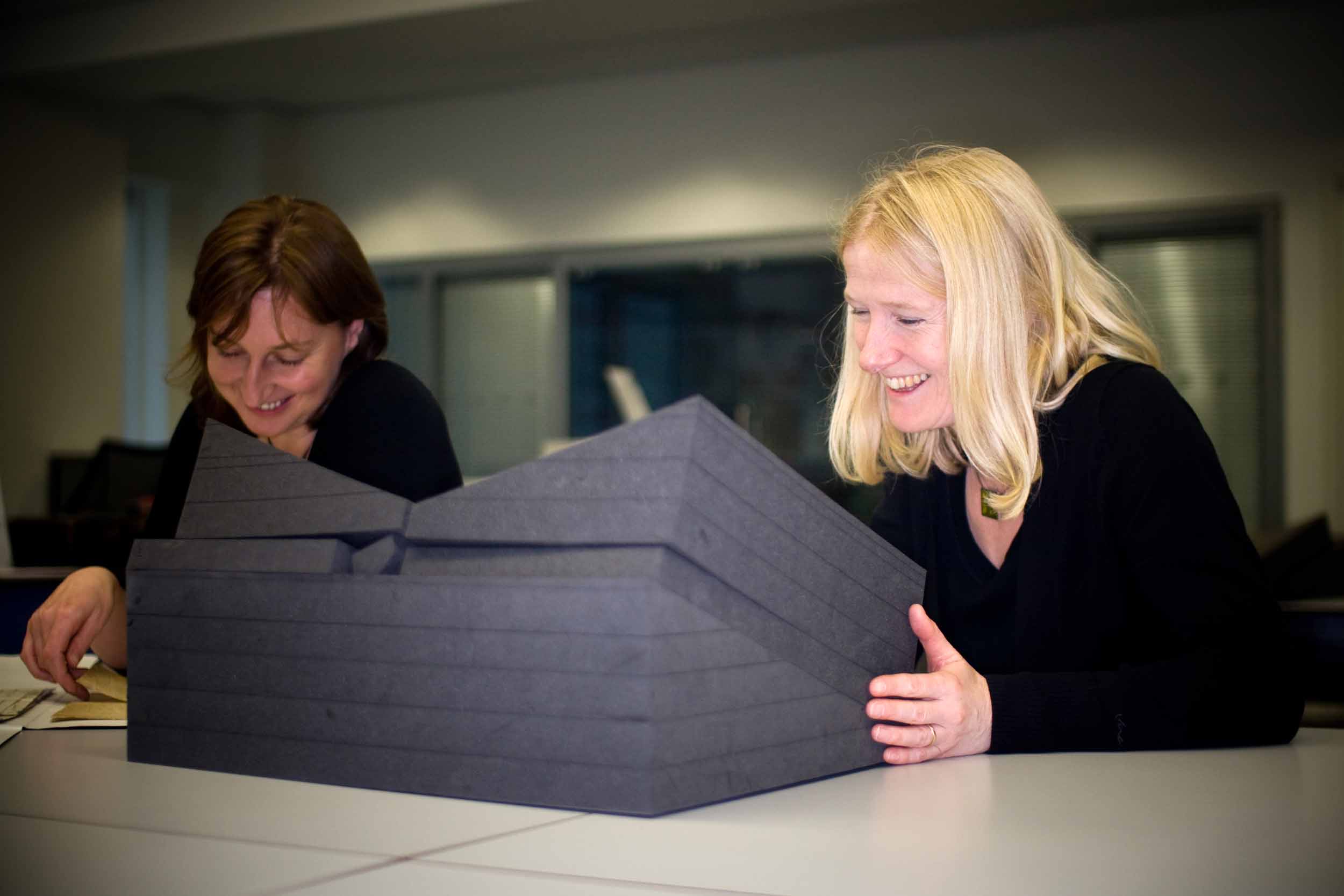
Livingstone Online research assistants Sharon Messenger and Caroline Overy at the Wellcome Library, 2009. Copyright Livingstone Online (Gary Li, photographer). Creative Commons Attribution-NonCommercial 3.0 Unported
Considerate collaboration Top ⤴
The directors of the Livingstone Online have drawn on the work of some sixty individuals with relevant professional skills, thanks to the three phases of Livingstone Online development (2005-09, 2010-12, 2013-present) and the three stages of the Livingstone Spectral Imaging Project (2009-10, 2010-12, 2013-present).
These individuals come from a variety of fields such as literature, history, library science, computer programming, imaging science, law, data management, and program management. In some cases, we have been fortunate to support the work of these individuals with funds from the National Endowment for the Humanities, the British Academy, the Wellcome Trust, the University of Nebraska-Lincoln, and Indiana University of Pennsylvania.
However, rarely has funding matched effort expended. Indeed much of our support has come pro bono, motivated mainly by goodwill or a shared belief in the goals of our project. We are very attentive to the nature of this support and grateful for it. Throughout the site, indeed wherever possible, we strive to recognize the contributions of our collaborators by citations, text, images, and other forms of public acknowledgment.
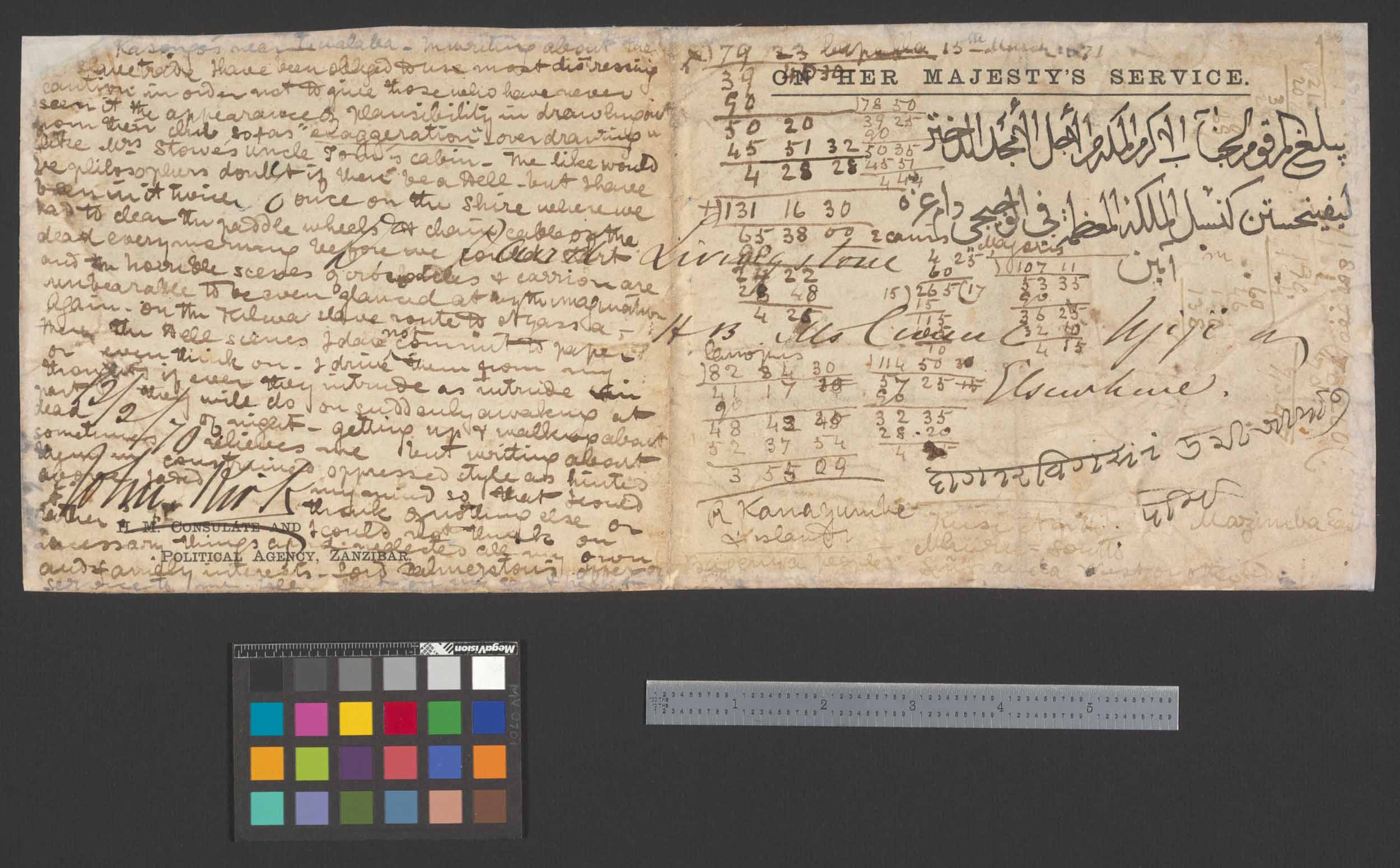
Fragment of 1871 Field Diary, 11 August 1871 - 9 September 1871, by David Livingstone. Copyright National Library of Scotland and Dr. Neil Imray Livingstone Wilson. Creative Commons Attribution-NonCommercial 3.0 Unported
Transparency and accountability Top ⤴
We take pride in being a public project, by which we mean a project that is publicly funded and that recognizes the importance of being publicly accountable – particularly as some of our leading partner institutions include public universities such as the University of Nebraska-Lincoln and the University of Maryland.
We seek to make all aspects of our work uniformly transparent to the fullest extent possible. We hope that our emphasis on transparency will enable funders to support our work with confidence and will allow users to learn about our work in depth, in the best spirit of knowledge transfer.
We provide extensive documentation – which we consider the foundation of responsible scholarship and science – for all aspects of our project. This documentation includes detailed project histories, numerous images of the project team at work, and a broad array of downloadable project documents created in the course of our research. Indeed, we take pride in the fact that we allow users to look behind the scenes of our work in a manner equaled by few other digital projects.
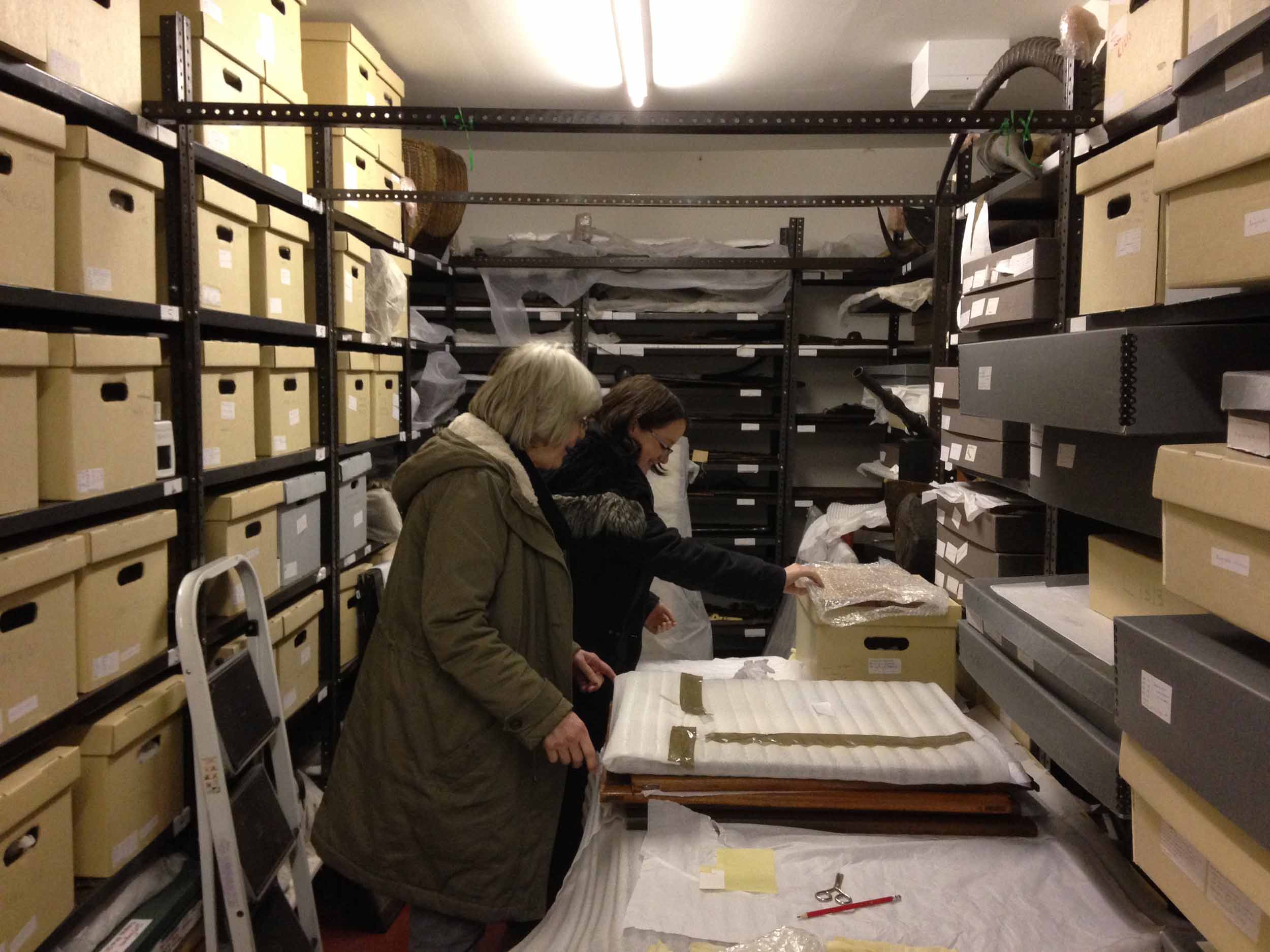
Anne Martin and Alison Ritchie in the archives of the David Livingstone Centre, 2014, by Adrian Wisnicki. Copyright Livingstone Online. Creative Commons Attribution-NonCommercial 3.0 Unported
Commitments to long-term sustainability and open access and use Top ⤴
It is never lost on us that we are conducting advanced digital research at a time when public funding for the humanities is diminishing drastically. As a result, we work to ensure the responsible expenditure of our funding. In particular, this commitment has infused our development of the Livingstone Online website.
We have adhered to industry best practices in building our site and have created our core data to reflect international archival standards. We are also working on integrating the site into the University of Maryland Libraries to capitalize of their robust system of data management and backup, and to ensure that the site is maintained long term as part of their overall digital collection. In the future, we also plan to mirror the site in the UK in order to help preserve our data.
All of our data is freely available to the public and, wherever possible, released under Creative Commons so that it can be reused in a broad variety of educational contexts. Users can access our data both as mediated by our site or, should they prefer, as flat image, transcription, and metadata files that can readily be incorporated into other digital projects. We have also designed our site carefully so that it caters to modern internet sensibilities and so that it promotes not just access but sustained use of all our materials.
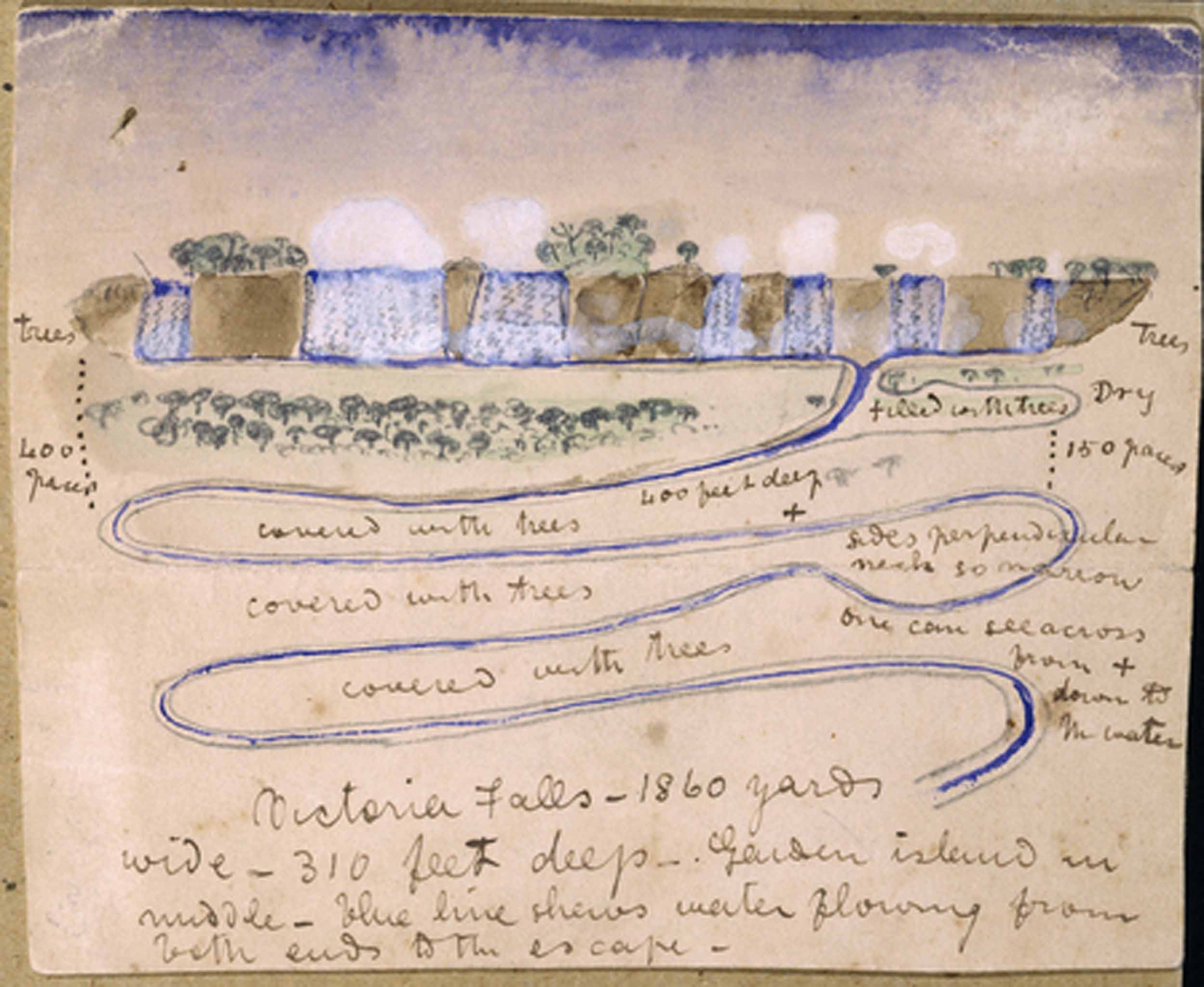
Sketch of the Victoria Falls, c.1850-1860, by David Livingstone. Copyright Royal Geographical Society (with IBG). Used by permission for academic purposes only. For non-academic use permission, please contact the Picture Library.
* * *
The Livingstone Online code, then, has many important facets. These facets work together to guide efforts of a project in which we take immense pride and which we hope, will introduce David Livingstone’s manuscript legacy – an important part of our shared, international, cultural heritage – to a whole new generation of readers.






![David Livingstone, Map of Lakes Nyassa and Shirwa, [1864?]. Copyright National Library of Scotland: CC BY-NC-SA 2.5 SCOTLAND, and Dr. Neil Imray Livingstone Wilson: CC BY-NC 3.0 David Livingstone, Map of Lakes Nyassa and Shirwa, [1864?]. Copyright National Library of Scotland: CC BY-NC-SA 2.5 SCOTLAND, and Dr. Neil Imray Livingstone Wilson: CC BY-NC 3.0](https://livingstoneonline.org:443/sites/default/files/section_page/carousel_images/liv_000077_0001-carousel.jpg)


